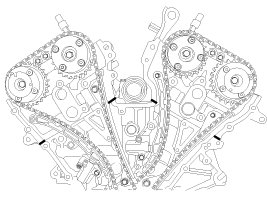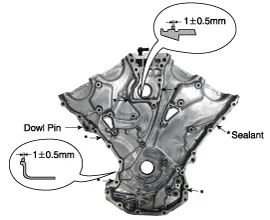Hyundai Genesis (DH): Timing System / Timing Chain Cover Repair procedures
Hyundai Genesis (DH) 2013-2016 Service Manual / Engine Mechanical System / Timing System / Timing Chain Cover Repair procedures
| Removal |
| 1. |
Remove the lower oil pan.
(Refer to Lubrication System - "Oil Pan") |
| 2. |
Drain the coolant.
(Refer to Cooling System - "Coolant") |
| 3. |
Remove the air cleaner assembly.
(Refer to Intake And Exhaust System - "Air Cleaner") |
| 4. |
Remove the surge tank.
(Refer to Intake And Exhaust System - "Surge Tank") |
| 5. |
Remove the intake manifold.
(Refer to Intake And Exhaust System - "Intake Manifold") |
| 6. |
Remove the LH/RH cylinder head cover.
(Refer to Cylinder Head Assembly - "Cylinder Head Cover") |
| 7. |
Remove the drive belt.
(Refer to Timing System - "Drive Belt") |
| 8. |
Remove the idler.
(Refer to Timing System - "Idler") |
| 9. |
Remove the drive belt auto tensioner.
(Refer to Timing System - "Drive Belt Tensioner") |
| 10. |
Remove the oil filter body.
(Refer to Lubrication System - "Oil Filter Body") |
| 11. |
Remove the crankshaft damper pulley.
(Refer to Timing System - "Crankshaft Damper Pulley") |
| 12. |
Remove the water pump.
(Refer to Cooling System - "Water Pump") |
| 13. |
Remove the timing chain cover (A).
|
| Installation |
| 1. |
Install the timing chain cover.
|





